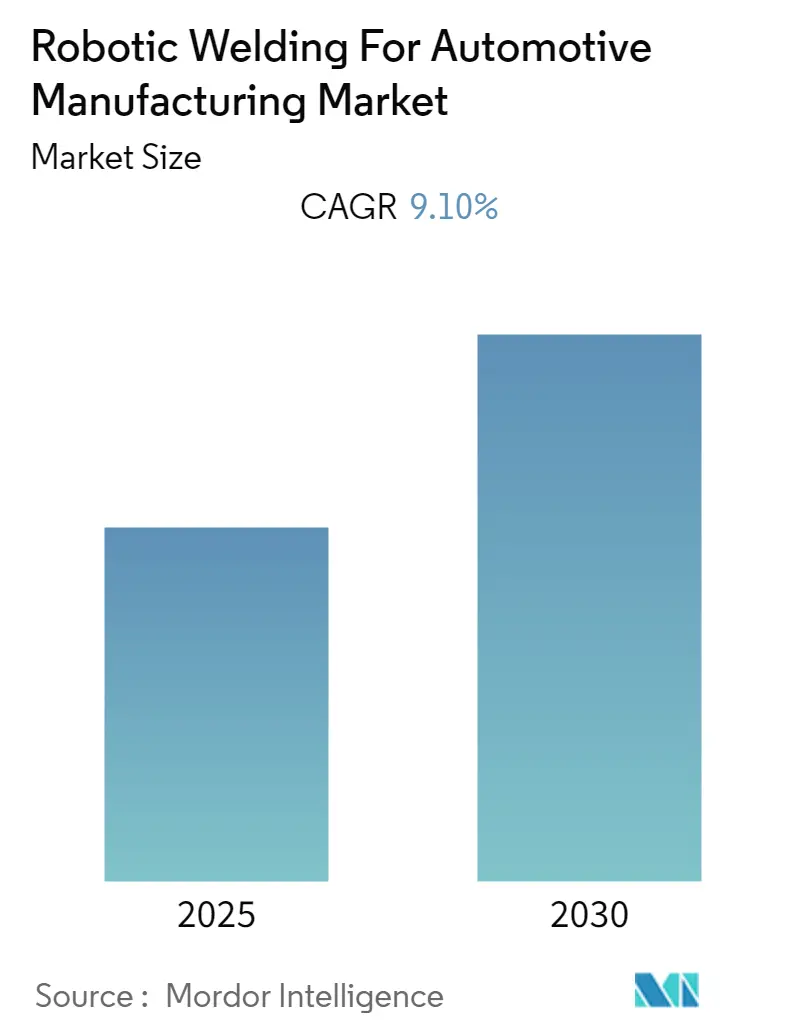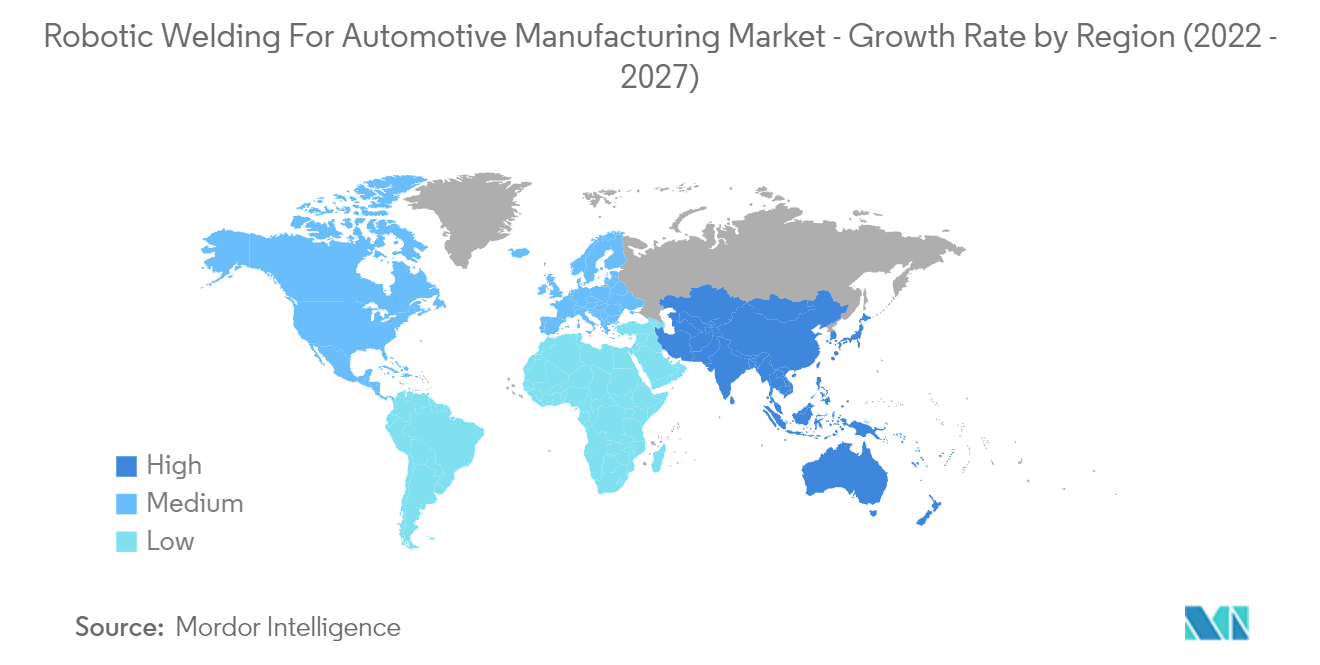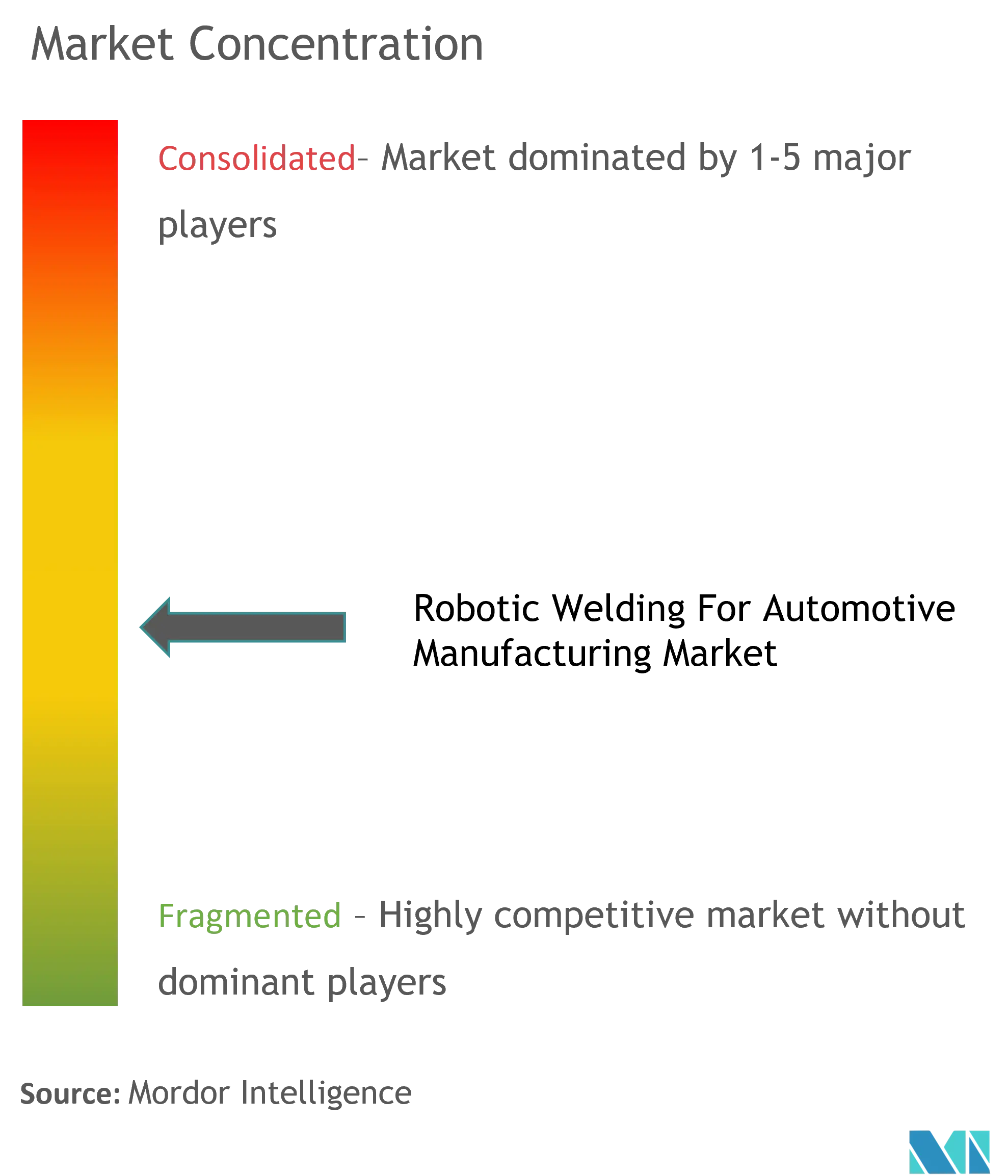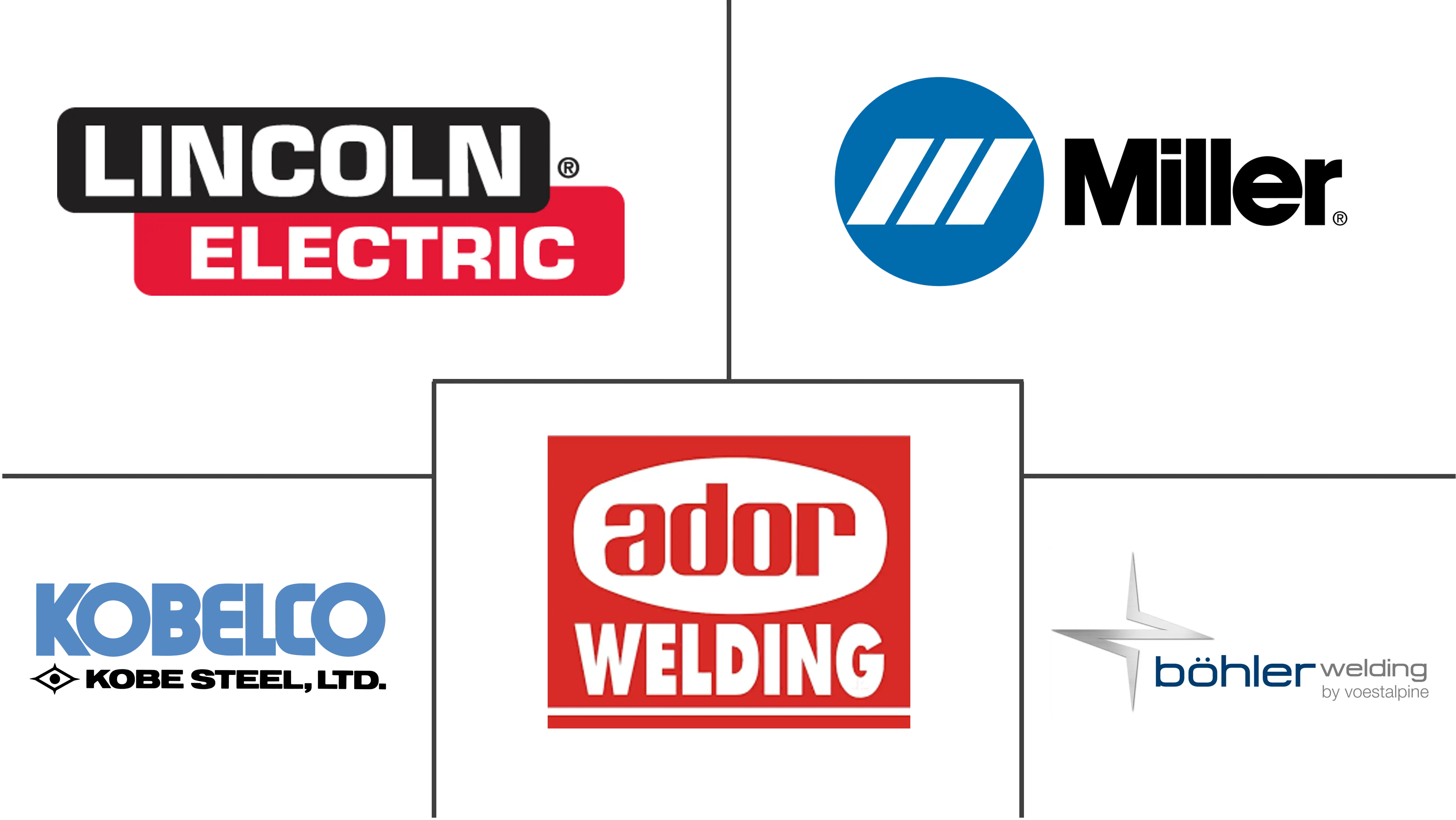Robotic Welding For Automotive Manufacturing Market Size and Share

Robotic Welding For Automotive Manufacturing Market Analysis by Mordor Intelligence
The Robotic Welding For Automotive Manufacturing Market is expected to register a CAGR of 9.1% during the forecast period.
- Robotic welding is an automated procedure that uses mechanized, programmed tools to weld and handles equipment in the industry. Industrial robots are becoming increasingly important in a variety of industries, like the automotive industry. Furthermore, the use of robots has resulted in exceptional results in terms of surface polish and dimensional accuracy throughout the sector.
- The automotive industry is anticipated to increasingly use robotic welding as a result of the transforming automotive industry. The industry has been known to use complex technology in order to make the most of high tensile strength steel for a robust assembling process. Spot welding is likely to have an impact on the expansion of these technologies in the automotive industry.
- The increasing global demand for automobiles is a major element driving the robotic welding growth. In addition, increased human-safety concerns in vehicle production plants are driving up demand for small, medium, and high-payload welding robots. In the automotive industry, a more complicated system is required for uninterrupted flow. Welding robots are given a range of commands to keep the assembly process moving. Using an autonomous robotic welding system, the machine is involved in the whole line function.
- Additionally, in 2020, the COVID-19 outbreak and spread had a negative impact on the robotic welding market, resulting in lower shipments of welding robots and associated peripherals. As a result, the revenue earned by them has decreased. As a result, the market's growth trajectory slowed significantly in the first half of 2020. This pattern persisted until the first quarter of 2021.
- However, low-skilled workers are progressively being replaced and displaced by welding robots. In the long run, however, reskilling and upskilling would result in the creation of more jobs in the majority of developed countries, but not in developing countries, where the proportion of low-skilled workers is far larger. The adoption of automation in emerging countries may have a detrimental impact because SMEs make up the bulk of any industry and are also the largest employees.
Global Robotic Welding For Automotive Manufacturing Market Trends and Insights
Electric Vehicles Will Augment the Demand for Robotic Welding
- Robotic welding is becoming increasingly popular in the automotive and transportation industries around the world. The market's growth is influenced by the expansion of manufacturing facilities for electric vehicles and other automotive products, as well as electrical and electronic components.
- For instance, Ola chose ABB as one of its automation and robotics partners for its mega scooter plant in India in February 2021. Ola uses ABB robots and automation systems for painting, welding, motors, and battery assembly lines. As a result, robot welding systems are becoming more widely used across the country.
- Furthermore, according to Reuters, US manufacturing is recovering from the Corona crisis, with new orders increasing from USD 362.0 million in April 2020 to approximately USD 506.0 million in June 2021. Demand for welding robots and other factory automation equipment has risen even more, and demand is expected to rise even more in the coming years as a spate of new electric vehicles enter production.
- Also, Both old and young manufacturers are investing in EV plants. According to LMC Automotive, automakers will invest over USD 37.0 billion in North American manufacturing from 2019 to 2025, with a large amount of that going toward EV-related efforts. Such factors will boost the demand for robotic welding in the automotive manufacturing sector.

Europe Will Be at the Forefront of Robotic Welding In Automotive Manufacturing Industry
- As during projection period, Europe is expected to increase steadily. Developed countries such as Germany and the United Kingdom are contributing to the region's market growth. Automated welding is being widely adopted in Italy and France, which will be a major driver of market expansion in the region.
- BMW AG, based in Germany, inked a framework deal with KUKA AG in April 2020 to supply 5,000 robots for new manufacturing lines and factories. These robots are intended to be utilized at BMW Group's various production locations across the world to produce current and future generation BMW cars.
- Furthermore, increased demand for vehicles, particularly from emerging nations across Europe, has prompted automakers and OEMs to automate their processes in order to improve manufacturing output. The need for welding robots in the automotive and transportation industries has risen as a result of this.
- Welding robots have been subjected to new product offers from notable manufacturers, which are leading to the use of automation technology in industrial welding more efficiently than ever before, owing to rising competitive costs and industry demand. Key players are concentrating on strengthening their welders' programming skills in order to get experience with complex software controls.

Competitive Landscape
Welding robots in automotive manufacturing have been exposed to new product offers from renowned manufacturers, which are leading to the deployment of automation technology in industrial welding more efficiently than ever before, owing to rising competitive costs and industry demand. Key players are concentrating on strengthening their welders' programming skills in order to get experience with complex software controls. In order to build new machinery and systems, industry participants are also working on introducing new technologies.
- April 2022 - ABB launched new robots that offer welding capabilities. The IRB 5710 and 5720 robots are available in eight distinct configurations, ranging from 70 to 180 kg payload and 2.3 to 3 meters reach. Material handling, machine tending, and assembly, as well as specific EV manufacturing processes such as battery module selection and placement, high-precision assembly, and component handling, are all possible applications.
Robotic Welding For Automotive Manufacturing Industry Leaders
-
Lincoln Electric Holdings Inc
-
Miller Electric Manufacturing LLC
-
Kobe Steel Ltd
-
Ador Welding Limited
-
Voestalpine Bohler Welding GmbH
- *Disclaimer: Major Players sorted in no particular order

Recent Industry Developments
- June 2022 - Kawasaki Robotics has teamed up with Realtime Robotics, a maker of autonomous motion planning for industrial robots, to automate the programming, implementation, and control of its industrial robots. Two BX100N Kawasaki robots are combined with Kawasaki Robotics' open programming platform, KRNX, and Realtime Robotics' breakthrough motion planning and collision avoidance software in the spot-welding demo cell.
- May 2021 - Path Robotics, situated in the United States, has raised USD 56.0 million for aggressive AI-powered expansion. The company is a global leader in robotic welding and has developed a self-contained system.
Global Robotic Welding For Automotive Manufacturing Market Report Scope
Robotic welding is capable of meeting a variety of automotive and transportation industry needs. As a result, automakers are investing heavily in implementing smart manufacturing technologies in their factories. Due to their extended arms and enormous payload capacities, big robots are commonly utilized to spot weld large vehicle body panels.
Smaller robots, on the other hand, may be able to weld lightweight parts like brackets and mounts. Robotic MIG and TIG welders are also popular because their torches may remain in the same position during each cycle. These robots can achieve acceptable welding standards because their arc and speed gaps are repeatable.
Additionally, the market scope comprises products such as Resistance Spot Welding, Resistance Seam Welding, Laser Beam Welding, and others (Metal Inert Gas (MIG) Welding, Friction Welding, Medium Frequency Welding, Magnetic Pulse Welding, etc.).
| Resistance Spot Welding |
| Resistance Seam Welding |
| Laser Beam Welding |
| Others (Metal Inert Gas (MIG) Welding, Friction Welding, Medium Frequency Welding, Magnetic Pulse Welding, etc.) |
| North America |
| Europe |
| Asia Pacific |
| Rest of The World |
| Product | Resistance Spot Welding |
| Resistance Seam Welding | |
| Laser Beam Welding | |
| Others (Metal Inert Gas (MIG) Welding, Friction Welding, Medium Frequency Welding, Magnetic Pulse Welding, etc.) | |
| Geography | North America |
| Europe | |
| Asia Pacific | |
| Rest of The World |
Key Questions Answered in the Report
What is the current Robotic Welding For Automotive Manufacturing Market size?
The Robotic Welding For Automotive Manufacturing Market is projected to register a CAGR of 9.1% during the forecast period (2025-2030)
Who are the key players in Robotic Welding For Automotive Manufacturing Market?
Lincoln Electric Holdings Inc, Miller Electric Manufacturing LLC, Kobe Steel Ltd, Ador Welding Limited and Voestalpine Bohler Welding GmbH are the major companies operating in the Robotic Welding For Automotive Manufacturing Market.
Which is the fastest growing region in Robotic Welding For Automotive Manufacturing Market?
Asia-Pacific is estimated to grow at the highest CAGR over the forecast period (2025-2030).
Which region has the biggest share in Robotic Welding For Automotive Manufacturing Market?
In 2025, the Europe accounts for the largest market share in Robotic Welding For Automotive Manufacturing Market.
What years does this Robotic Welding For Automotive Manufacturing Market cover?
The report covers the Robotic Welding For Automotive Manufacturing Market historical market size for years: 2019, 2020, 2021, 2022, 2023 and 2024. The report also forecasts the Robotic Welding For Automotive Manufacturing Market size for years: 2025, 2026, 2027, 2028, 2029 and 2030.
Page last updated on:
Robotic Welding For Automotive Manufacturing Market Report
Statistics for the 2025 Robotic Welding For Automotive Manufacturing market share, size and revenue growth rate, created by Mordor Intelligence™ Industry Reports. Robotic Welding For Automotive Manufacturing analysis includes a market forecast outlook for 2025 to 2030 and historical overview. Get a sample of this industry analysis as a free report PDF download.



